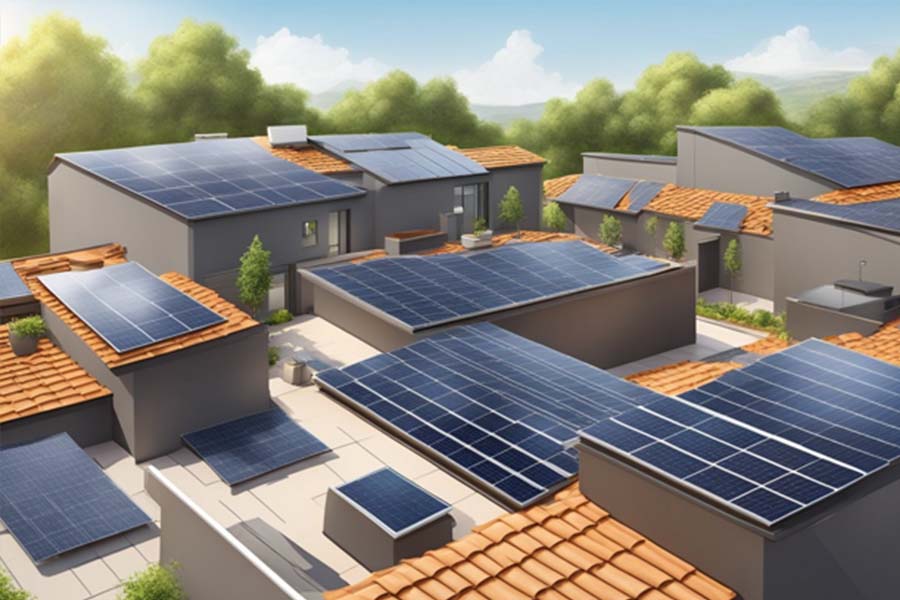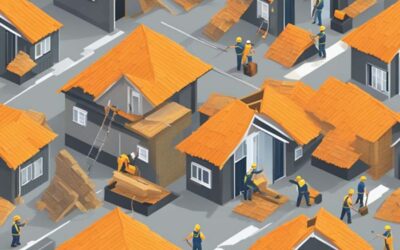Asphalt shingles have been a popular roofing material for decades due to their affordability and durability. However, homeowners are increasingly exploring alternative roofing options that are more eco-friendly and visually appealing. In this article, we will explore some of the alternatives to asphalt shingles that homeowners can consider for their roofs.
One option that has gained popularity in recent years is metal roofing. Metal roofs are durable, energy-efficient, and can last up to 50 years or more. They come in a variety of styles and colors, and can even mimic the look of traditional shingles or tiles. Additionally, metal roofs are recyclable and can be made from recycled materials, making them an eco-friendly option for homeowners who are concerned about sustainability.
Benefits of Alternative Roofing Materials
When it comes to roofing materials, asphalt shingles have been the go-to choice for many homeowners for decades. However, there are several alternative roofing materials that offer a range of benefits over asphalt shingles.
One of the main benefits of alternative roofing materials is their durability. Materials like metal, clay, and concrete tiles are known for their long lifespan and ability to withstand harsh weather conditions. This means that homeowners can save money in the long run by not having to replace their roof as frequently.
Another benefit of alternative roofing materials is their energy efficiency. Materials like metal and clay tiles reflect more sunlight than asphalt shingles, which can help keep the home cooler during hot summer months. This can lead to lower energy bills and a more comfortable living space.
In addition, alternative roofing materials can offer unique aesthetic options for homeowners. Materials like wood shingles and shakes can give a home a rustic, natural look, while metal roofing can provide a sleek, modern appearance. This allows homeowners to choose a roofing material that complements the style of their home and adds to its overall curb appeal.
Overall, exploring alternative roofing materials can offer homeowners a range of benefits, including increased durability, energy efficiency, and aesthetic options. By considering these materials, homeowners can make an informed decision about which roofing option is best for their home.
Types of Roofing Alternatives
Metal Roofing
Metal roofing is a popular alternative to asphalt shingles due to its durability and longevity. Metal roofs can last up to 50 years and are resistant to fire, insects, and rot. They are also lightweight and energy-efficient, which can help reduce energy costs. Metal roofing comes in a variety of styles and colors, including standing seam, corrugated, and metal shingles.
Solar Tiles
Solar tiles are a newer roofing alternative that combines the benefits of solar panels and roofing materials. These tiles are designed to look like traditional roofing materials, such as asphalt shingles or slate tiles, but they are equipped with solar cells that can generate electricity. Solar tiles are a great option for homeowners who want to reduce their carbon footprint and save money on energy costs.
Green Roofing
Green roofing, or living roofs, are roofs that are covered in vegetation, such as grass, flowers, or even trees. This roofing alternative is becoming increasingly popular due to its environmental benefits, including improved air quality, reduced urban heat island effect, and increased biodiversity. Green roofs can also help reduce energy costs by providing insulation and cooling the air around the building.
Slate Tiles
Slate tiles are a natural roofing alternative that is known for its durability and aesthetic appeal. Slate tiles can last up to 100 years and are resistant to fire, insects, and rot. They also come in a variety of colors and textures, which can help enhance the curb appeal of a home. However, slate tiles are heavier than other roofing materials and may require additional support.
Rubber Slate
Rubber slate is a synthetic roofing alternative that is designed to look like natural slate tiles. Rubber slate is lightweight, durable, and resistant to fire, insects, and rot. It is also more affordable than natural slate tiles and can be installed on a variety of roof types. Rubber slate comes in a variety of colors and textures, making it a versatile option for homeowners.
Clay and Concrete Tiles
Clay and concrete tiles are a popular roofing alternative that is known for its durability and aesthetic appeal. These tiles can last up to 50 years and are resistant to fire, insects, and rot. They also come in a variety of colors and textures, which can help enhance the curb appeal of a home. Clay and concrete tiles are heavier than other roofing materials and may require additional support.
Environmental Impact of Roofing Materials
Recyclability and Sustainability
When it comes to choosing a roofing material, one of the key factors to consider is its impact on the environment. Asphalt shingles are the most commonly used roofing material in the United States, but they are not the most sustainable option. Asphalt shingles are not recyclable, and they contribute to the buildup of waste in landfills.
On the other hand, many alternative roofing materials are recyclable and sustainable. Metal roofing, for example, is made from recycled materials and can be recycled again at the end of its life. Clay and concrete tiles are also recyclable, and they have a long lifespan which reduces the need for replacements.
Energy Efficiency
Another important factor to consider is the energy efficiency of the roofing material. A roof that reflects sunlight can help to reduce energy costs by keeping the home cooler in the summer. This is particularly important in hot climates where air conditioning costs can be high.
Metal roofing is one of the most energy-efficient roofing materials available. It reflects sunlight, which helps to reduce the amount of heat that is absorbed by the roof. This can result in lower energy bills and a more comfortable home.
Manufacturing and Transportation
The manufacturing and transportation of roofing materials also have an impact on the environment. Materials that are produced locally require less transportation, which reduces the carbon footprint of the roofing material.
Metal roofing is often made from recycled materials, which reduces the need for new materials to be produced. Additionally, metal roofing can be produced locally, which reduces the environmental impact of transportation.
Overall, there are many roofing materials available that are more sustainable and energy-efficient than asphalt shingles. By considering the impact of the roofing material on the environment, homeowners can make a choice that is both environmentally friendly and cost-effective.
Durability and Maintenance
Lifespan Comparison
When considering roofing materials, durability is a key factor to consider. Asphalt shingles have a typical lifespan of 20-30 years, while other materials can last much longer. Metal roofs, for example, can last up to 50 years or more with proper maintenance. Tile roofs can also last 50 years or more, and some natural materials like slate can last up to 100 years.
Maintenance Requirements
Another important factor to consider is the maintenance required for different roofing materials. Asphalt shingles require regular inspections and maintenance to prevent damage and ensure their longevity. Metal roofs, on the other hand, require little maintenance beyond occasional cleaning. Tile roofs may require some maintenance to replace broken tiles, but overall they are very durable and low-maintenance. Natural materials like slate may require occasional repairs, but they are generally very long-lasting and require minimal maintenance.
Weather and Impact Resistance
In addition to lifespan and maintenance, it’s important to consider how different roofing materials will hold up against weather and impact. Asphalt shingles can be damaged by heavy winds, hail, and extreme temperatures, while metal roofs are more resistant to these types of damage. Tile roofs are very durable and can withstand heavy winds and hail, but they may be more susceptible to cracking in extreme temperatures. Natural materials like slate are very strong and can withstand a variety of weather conditions, but they may be more prone to damage from impact.
Overall, there are many alternatives to asphalt shingles that offer greater durability and require less maintenance. When choosing a roofing material, it’s important to consider factors like lifespan, maintenance requirements, and weather and impact resistance to ensure that you choose a material that will last for many years to come.
Cost Analysis
Initial Installation Costs
When considering alternatives to traditional asphalt shingles for your roof, it’s important to take into account the initial installation costs. While some options may be more expensive upfront, they may offer long-term cost savings. For example, metal roofs tend to have a higher initial cost than asphalt shingles, but they have a longer lifespan and require less maintenance.
Another factor to consider is the complexity of the installation. Some materials, such as clay tiles or slate, may require specialized installation techniques, which can increase the cost of installation. On the other hand, materials like rubber or plastic shingles may be easier to install, which can lower the overall cost.
Long-Term Cost Effectiveness
In addition to the initial installation costs, it’s important to consider the long-term cost effectiveness of the roofing material. This includes factors such as energy efficiency, durability, and maintenance requirements.
For example, a metal roof may be more expensive upfront, but it can save homeowners money in the long run by reducing energy costs. Metal roofs are highly reflective and can help keep the home cooler in the summer, which can reduce the need for air conditioning. Additionally, metal roofs have a longer lifespan than asphalt shingles, which means they require less maintenance and replacement over time.
Warranty and Insurance Considerations
Finally, when exploring alternative roofing materials, it’s important to consider the warranty and insurance considerations. Some materials may come with longer warranties than others, which can provide homeowners with peace of mind and protection against unexpected expenses.
Additionally, some roofing materials may be more prone to damage from natural disasters, such as hurricanes or wildfires. Homeowners should check with their insurance provider to see if there are any restrictions or additional costs associated with using a certain roofing material.
Overall, there are many factors to consider when exploring alternatives to asphalt shingles for your roof. By carefully weighing the initial installation costs, long-term cost effectiveness, and warranty and insurance considerations, homeowners can make an informed decision that meets their needs and budget.
Aesthetic and Design Options
Color and Texture Varieties
When it comes to the aesthetic appeal of a roof, color and texture options are crucial. Alternative roofing materials offer a wide range of color options and textures that can complement any architectural style. For example, metal roofing comes in a variety of colors and finishes, including copper and zinc, which can add a unique and elegant touch to a home. Additionally, synthetic slate and shake roofing can mimic the look and texture of natural materials, such as wood and slate, without the maintenance and durability issues associated with these materials.
Architectural Styles Compatibility
The design of a roof should complement the architectural style of a home. Many alternative roofing materials, such as clay and concrete tiles, are well-suited for Mediterranean and Spanish-style homes, while metal roofing is a popular choice for contemporary and modern architecture. Synthetic roofing materials, such as composite shingles, can be designed to match the look of traditional asphalt shingles and are suitable for a variety of architectural styles.
Customization Potential
Alternative roofing materials offer a high degree of customization potential. For instance, metal roofing can be formed into a variety of shapes and sizes to accommodate unique roof designs. Additionally, synthetic roofing materials can be cut and shaped to fit any roof shape or size. This flexibility allows homeowners to create a truly unique and personalized look for their home.
In conclusion, exploring alternative roofing materials can offer a wide range of aesthetic and design options. From color and texture varieties to architectural styles compatibility and customization potential, homeowners can find the perfect roofing material to complement their home’s unique style and design.
Installation and Contractors
Finding Qualified Contractors
When looking for a contractor to install your new roof, it is important to find someone who is qualified and experienced. Ask for references and check their credentials to ensure they are licensed and insured. It is also a good idea to get quotes from multiple contractors to compare prices and services.
Installation Best Practices
Proper installation is crucial for the longevity and effectiveness of your new roof. Make sure the contractor follows manufacturer guidelines and uses quality materials. Additionally, ensure that the installation process includes proper ventilation and insulation to prevent damage from moisture and heat.
Regional Considerations
Different regions may have specific requirements for roofing materials and installation practices. It is important to research and comply with local building codes and regulations. Additionally, climate and weather patterns should be taken into consideration when selecting roofing materials and installation methods.
By following these best practices and considerations, homeowners can ensure a successful and long-lasting roof installation.
Building Codes and Regulations
When considering alternative roofing materials, it is important to be aware of building codes and regulations in your area. Building codes are put in place to ensure the safety of structures and their occupants. Failure to comply with these codes can result in fines and even legal action.
Many building codes specify the types of roofing materials that are allowed in certain areas. Some materials may be prohibited due to their flammability or other safety concerns. It is important to check with your local building department to ensure that any alternative roofing materials you are considering are allowed in your area.
In addition to building codes, there may also be homeowner association (HOA) regulations to consider. HOAs may have specific guidelines for roofing materials and colors that must be followed. Failure to comply with these regulations can result in fines or even legal action.
Before making any decisions about alternative roofing materials, it is important to do your research and ensure that you are in compliance with all building codes and regulations in your area. This will help ensure the safety of your home and avoid any potential legal issues.
Consumer Reviews and Testimonials
When considering alternative roofing materials, it is important to take into account the experiences of other homeowners who have already made the switch. Here are some consumer reviews and testimonials for popular roofing options:
Metal Roofing
Many homeowners who have installed metal roofs report high levels of satisfaction with their choice. They appreciate the durability, energy efficiency, and low maintenance requirements of metal roofing. One homeowner commented, “Our metal roof has held up through several severe storms and we haven’t had any leaks or damage. Plus, it looks great and adds to the curb appeal of our home.”
Clay Tiles
While clay tiles are known for their longevity and aesthetic appeal, some homeowners have reported issues with cracking and breakage. However, those who have had success with clay tiles praise their ability to withstand extreme temperatures and resist fire and pests. One homeowner shared, “We live in a high fire risk area and the clay tiles have given us peace of mind knowing our home is well-protected.”
Synthetic Shingles
Synthetic shingles, made from materials such as rubber or plastic, are becoming increasingly popular for their cost-effectiveness and versatility. Homeowners who have installed synthetic shingles appreciate their ability to mimic the look of traditional roofing materials while offering better durability and resistance to weather damage. One homeowner noted, “We were able to get the look of cedar shakes without the maintenance and expense. Our synthetic shingles have held up well and we’ve received many compliments on the appearance.”
Overall, it is important to do thorough research and weigh the pros and cons of each roofing option before making a decision. By considering consumer reviews and testimonials, homeowners can gain valuable insights and make an informed choice for their home.





0 Comments